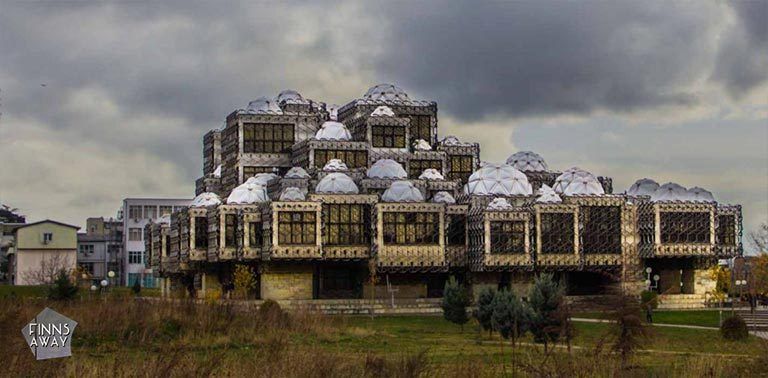
Road trip through Kosovo and feeling blue in Pristina
We made two holiday trips to the Balkans few years ago, visiting all the surrounding countries but not the small Kosovo in the middle of Balkan countries. We had very limited time to travel back then, and were in hurry to get from one Balkan country to another. Kosovo was a bit too far away from our route back then, so we had to leave it out of the travel plan. Now the new nomadic lifestyle allows us to travel more slowly, and when we were staying in Skopje, Macedonia in November, it was an easy decision to finally see also Kosovo.
Kosovo has a long history, but as an independent country it is very young. It declared independence from Serbia in 2008, and the status of Kosovo is still disputed. Altogether 110 UN countries recognize its independence, but Serbia still considers Kosovo as an autonomic province. Both countries used to be part of communist Yugoslavia, and there was tension between Kosovo’s Albanian and Serb communities simmering for decades. It all culminated in the destructive Kosovo war in 1998-99. Nowadays Kosovo is stable and safe to travel, and people are hospitable and willing to help out tourists.
Driving in Kosovo
Since the usual European Green Card insurance is not valid in Kosovo, you’ll need a separate insurance for driving your own wheels. It is easy to get one though, just buy it at the border when entering the country. The price for the insurance seems to change quite often, since when searching for the price beforehand we found various info. In November 2017 the price when entering from Macedonia was 15 EUR for a stay up to 15 days. Insurance also for longer periods is available at the border crossings. After buying the green card with credit card (it’s payable also by cash in euros, but in our case they didn’t have change) the border crossing was quick and easy.
Driving in Kosovo is somewhat annoying; roads are not in very good condition and people seem to park for short term where-ever they want, blocking the lanes and causing interesting bypassing situations. Capital city Pristina seemed to be a bit too small for the current amount of the cars and the traffic gets jammed during rush hours.
Why didn’t Pristina impress us?
When we arrived Pristina mid November, the weather was unusually cold and wet. We had booked accommodation beforehand from a centrally located hostel, that proved to be just next to a busy market street. The price of accommodation in Pristina is surprisingly high compared to neighboring countries; the cheapest room we could find from booking.com cost 20 euros per night, with shared bathroom. After the spacious and new apartment that we had in Skopje, the hostel room felt small, shabby and very cold. We luckily had an electronic heater in the room, but still the floor was cold, not to even talk about the common areas and bathrooms. We tried to ignore the small downsides, but weren’t willing to stay more than the booked two nights in the hostel.
To get to know the city we made a walking tour when it was not raining, and checked out the main sights. Pedestrian area is quite nice and there are some impressive buildings, like the National Library that probably is one of the weirdest library buildings in the world. But somehow the city felt small and undeveloped. Maybe we just weren’t on the mood to dive into the atmosphere, and we didn’t even take much pictures. The ones that we took are all a bit depressing, as you can see in the gallery. We ate out, tasted local craft beers in an otherwise comfy but cold pub, and visited a jazz bar with live music. Nice, yes, but nothing special. After two days in rainy Pristina and checking the forecasts for coming week, we decided to escape the cold weather all the way to Albania, without stopping in other cities in Kosovo.
Don’t get this wrong, Pristina surely is a lively city especially during the summer months, and we should go back there someday to get to know it better. I guess I’m trying to say, that when you’re only on a short visit, your judgement of a city can be very clouded due to external conditions, like the weather, and due to your own state of mind. Sometimes it can be very small details that make you feel a bit uncomfortable or irritated, and then it might be hard to see the beauty around you, or feel the vibe of the place. That’s one reason why we are no longer into short stays, but trying to travel slowly instead whenever possible.
Other destinations in Kosovo
It’s a pity that our time in Kosovo was so limited, and that we basically saw only the capital. If only the weather allowed, we would have gone hiking to the mountains and stayed in smaller towns. Like in the city of Peja, which is an outdoor hub in the foot of the mountains. Or in the village of Brod in the southern part of the country, which is situated up in the mountains with jaw-dropping views and inhabited by the Goranci, who are primarily sheep herders. Or in Velika Hoca, a tiny Serbian village with medieval buildings including 13 churches, and the home of Decani wine. There are also handsome monasteries and fortresses in Kosovo, and a lot of mountainous nature to explore.
Somehow I’m quite certain that we will be back, some day.





